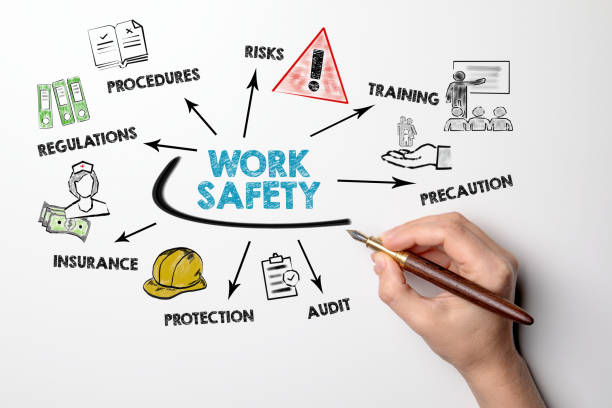Our History

The history of occupational safety and health (OSH) in Kenya dates back to the 1950s when the need to have a legal instrument to manage the safety, health and welfare of factory employees became indispensable. The then British government adopted the British Factories Act of 1937. The Act was later amended in 1990 to Factories and Other Places of Work Act to widen its scope of coverage to additional workplaces initially not included under the Factories Act of 1937. Kenya has ratified and adopted 49 ILO Conventions out of which ten are OSH-related. The country compiled its first national profile on OSH in 2004, while the most recent one was compiled in 2013 (ILO, 2013). The profile provides labour market insights necessary for creating a safe and healthy workplace ecosystem in the country.
In 2007, the Factories and Other Places of Work Act was repealed and replaced by the Occupational Safety and Health Act (2007), commonly known as OSHA 2007. In the same year, the Work Injury Benefits Act (WIBA) was enacted. The Occupational Safety and Health Act promotes safety at workplace, preventing work-related injuries and sickness, while protecting third party individuals from being predisposed to higher risk of injury and sickness associated with activities of people at places of work. The Work Injury Benefits Act was enacted to ensure that workers who sustain work-related injuries and contract diseases that are work-related get compensated. Inspection and enforcement systems exist with a bearing to occupational safety, health, and labour inspections. Inspections related to environment at work, such as safety of workplaces, general health and basic welfare of workers are executed by the Directorate of Occupational Health and Safety Services – DOSHS – to ensure compliance with OSHA (2007). Specifically, the core roles of DOSHS include: inspection of workplaces to foster.
Compliance with safety and health law; measurement of workplace pollutants for purposes of their control; investigation of occupational accidents and diseases and aiming to prevent recurrence; examination and testing of steam boilers, steam and air receivers, lifts, gas cylinders, cranes chains among other lifting equipment; training on OSH, first aid and fire safety; approving of architectural plans of buildings intended to serve as workplaces; medical examinations of workers; and dissemination of information on OSH to employers, workers, other key stakeholders and the general public.
DOSHS outlines that occupational accidents should be reported by an employer to the Director of Occupational Health and Safety Services on a prescribed form within 7 days following receipt of accident notice or on learning that an employee has been injured at work. In case of fatal accidents, the accident should be reported within 24 hours by fastest means possible and thereafter in writing to DOSHS within seven days.
The occupational diseases that an employee may seek compensation for are clearly indicated under the Workmen’s Compensation Act, Cap 236 and the Factories and Other Places of Work Act, Cap 514. Some of the occupational diseases include anthrax, tuberculosis, heat cataract, poisoning by or a compound of lead, manganese, phosphorus, mercury, benzene, nitrous fumes, byssinosis caused by cotton exposure, silicosis caused by exposure to any silica and asbestos caused by exposure to any asbestos, among others. In case of occupational injuries, the Act outlines on compensation to workers or their dependents depending on whether the injury is fatal or non-fatal. WIBA applies to all employees including those employed by the government but excluding members of the armed forces.
The National Council for Occupational Safety and Health (NACOSH) is a 22-member body that is responsible for formulating and reviewing OSH legislations and policies. To successfully undertake its mandate, substantial consultation, coordination and collaboration with key stakeholders and social partners at both the national and enterprise level is undertaken. As such, at national level, workers are represented by an appointed member of the Central Organization of Trade Unions – Kenya (COTU-K) while employers are represented by an appointed member of the Federation of Kenya Employers (FKE). Other members include government ministries and agencies, and appointed OSH practitioners.
At the enterprise level, OSHA 2007 facilitates a bipartite approach made possible by the Safety and Health Committees Rules (the Factories and Workplace (Safety and Health Committees) Rules, L.N. No. 31/2004) provisioned under the Act. Under both the Rules and the Act, the employer or occupier of any workplace which regularly employs at least 20 people is required to institute a safety and health committee in the workplace with a fair representation from workers and the management. The committee may, from time to time, invite to its meetings or interview experts when deliberating on OSH issues at workplace. The Director of DOSHS, or his assistants, may attend meetings organized by the committee. The committee is required to meet quarterly. This is to ensure proper consultation, coordination, and prevention of injuries for workplace safety and health.
Workers spend much of their time at work than in any other place. Like any other environment, the workplace is prone to health risks and hazards. Work-related injuries or diseases are obvious in any workplace. Globally, reports indicate that around 6,300 workers succumb to work-related injuries or diseases daily, which is an average of 2.3 million fatalities annually. Fatal and non-fatal on-the-job accidents attributed to poor occupational safety and health practices were approximated at 337 million per year. These accidents result to employee absenteeism from work for prolonged durations. Furthermore, there are over 160 million reported cases of occupational diseases, with a third of these cases resulting to at least four days absence from work annually. This leads to decreased productivity and performance, reduced revenue, and additional costs for compensating workers by firms. Such economic losses can be avoided, prevented, and controlled with the right measures put in place at the workplace. On households, some of the effects include increased dependency on other household members in cases where individuals are incapacitated and increased financial burden in cases where compensation is not forthcoming and loss of income/jobs.

